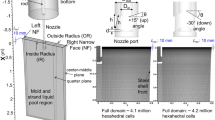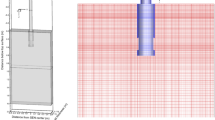Abstract
In steel continuous casting with submerged entry nozzles at a domestic steel plant, nozzle clogging was largely alleviated and defect rates of hot-rolled and cold-rolled sheets relating to slag entrainment were reduced for a nozzle with an approximately oval exit relative to a nozzle with a rectangular exit. Numerical and physical models were built to investigate the above phenomena. A turbulent model was applied in large eddy simulation to obtain the evolution of turbulent features within the nozzle and mold, while particle image velocimetry was adopted to monitor fluid flow beneath the slag–steel interface. Main results were that the flow speed of the main stream from the approximately oval exit was higher than that from the rectangular exit, while the zone of a velocity magnitude below 0.2 m/s within the approximately oval exit was smaller than that within the rectangular exit, indicating that inclusions tended to reside for longer in the latter. At the same casting speed, that slag entrainment occurred more frequently for the nozzle with a rectangular exit was found to have no direct relationship with the velocity magnitude and vorticity at 1/4 mold width on the top surface. Meanwhile, slag entrainment always occurred at the moment that vorticity changed most rapidly. The current study thus provided new insight into the structural parameter optimization of the submerged entry nozzle.












Similar content being viewed by others
References
[1] S.-M. Cho, B.G. Thomas, and S.-H. Kim: Metall. Mater. Trans. B, 2019, vol. 50B, pp. 52-76.
[2] M.M. Salazar-Campoy, R.D. Morales, A. Najera-Bastida: Metall. Mater. Trans. B, 2018, vol. 49B, pp. 812-830.
[3] R. Chaudhary, C. Ji, B.G. Thomas, and S.P. Vankal: Metall. Mater. Trans. B, 2011, vol. 42B, pp. 987-1007.
[4] J. Anagnostopoulos, G. Bergeles: Metall. Mater. Trans. B, 1999, vol. 30B, pp. 1095-1105.
[5] Y. Miki, S. Takeuchi: ISIJ Int., 2003, vol. 43B, pp. 1548-1555.
A. Ramos-Banderas, Sanchez-Perez, and R.D. Morales: Metall. Mater. Trans. B, 2004, vol. 35B, pp. 449–60.
[7] R. Liu, K. Blazek, B. Forman, C. Fritz, and C. Graham: Steel Res. Int., 2019, vol. 90B, pp. 1-12.
[8] F.M. Naijat, B.G. Thomas, and D.E. Hershey: Metall. Mater. Trans. B, 1995, vol. 26B, pp. 749-765.
[9] H. Bai, and B.G. Thomas: Metall. Mater. Trans. B, 2001, vol. 32B, pp. 269-284.
[10] I. Calderon-Ramos, R.D. Morales, and M. Salazar-Campoy: Metall. Mater. Trans. B, 2015, vol. 46B, pp. 1314-1325.
E. Gutierrez, G.H. Saul, and J.d.J. Barreto: Steel Res. Int., 2016, vol. 87B, pp. 1406–16.
[12] H. Bai, and B.G. Thomas: Metall. Mater. Trans. B, 2001, vol. 32B, pp. 707-722.
F.M. White: Viscous Fluid Flow, 2nd ed., McGraw-Hill Series in Mechanical Engineering, McGraw-Hill, Boston, 1991, pp. 614.
ANSYS FLUENT 14.5-Theory Guide, ANSYS. Inc., Canonsburg, PA, 2012.
[15] Q. Yuan, S. Sivaramakrishnan, S.P. Vanka, and B.G. Thomas: Metall. Mater. Trans. B, 2004, vol. 35B, pp. 967-982.
[16] Y.H. Ho, C.H. Chen, and W.S. Hwang: ISIJ Int., 1994, vol. 34, pp. 255-264.
[17] L. Len, Y. Ren, L.F. Zhang, and J.C. Yang: Steel Res. Int., 2019, vol. 90, pp. 1-11.
[18] Q. Yuan, S. Sivaramakrishnan, S.P. Vanka, and B.G. Thomas: Metall. Mater. Trans. B, 2004, vol. 35, pp. 967-982.
[19] M.M. Salazar-Campoy, R.D. Morales, A. Najera-Bastida: Metall. Mater. Trans. B, 2017, vol. 48B, pp. 1376-1389.
[20] Q. He: Isij Int., 1933, vol. 33, pp. 343-345.
[21] F.G. Wilson, M.J. Heesom, A. Nicholson, and A.W.D. Hills: Ironmak Steelmak, 1987, vol. 14, pp. 296-309.
H. Nakato, K. Saito, and Y Oguchi, et al.: 70 th Steelmaking Conf. Proc. Iron Steel Soc., 1987, pp. 427–31.
Y.H Wang: 10th Process Technology Conf., 1992. vol. 75, pp. 271–78.
[24] R. Hagemann, R.D. Schwarze, H.P. Heller, and P.R. Scheller: Metall. Mater. Trans. B, 2013, vol. 44B, pp. 80-90.
[25] K. Watanabe, K. Tsutsumi, M. Suzuki, M. Nakada, T. Shiomi: Isij Int., 2009, vol. 49, pp. 1161-1166.
Acknowledgments
The authors are grateful for support from the National Natural Science Foundation of China (Grant Nos. 51804057, U1660204, and 51874057). The authors also thank Prof. Lifeng Zhang, Ph.D students Haichen Zhou and Chang Liu for their numerous assistance on the instrument and technical guidance during water mold experiment.
Author information
Authors and Affiliations
Corresponding author
Additional information
Publisher's Note
Springer Nature remains neutral with regard to jurisdictional claims in published maps and institutional affiliations.
Manuscript submitted July 9, 2020; accepted September 24, 2020.
Rights and permissions
About this article
Cite this article
Gan, M., Pan, W., Wang, Q. et al. Effect of Exit Shape of Submerged Entry Nozzle on Flow Field and Slag Entrainment in Continuous Casting Mold. Metall Mater Trans B 51, 2862–2870 (2020). https://doi.org/10.1007/s11663-020-01990-x
Received:
Accepted:
Published:
Issue Date:
DOI: https://doi.org/10.1007/s11663-020-01990-x




